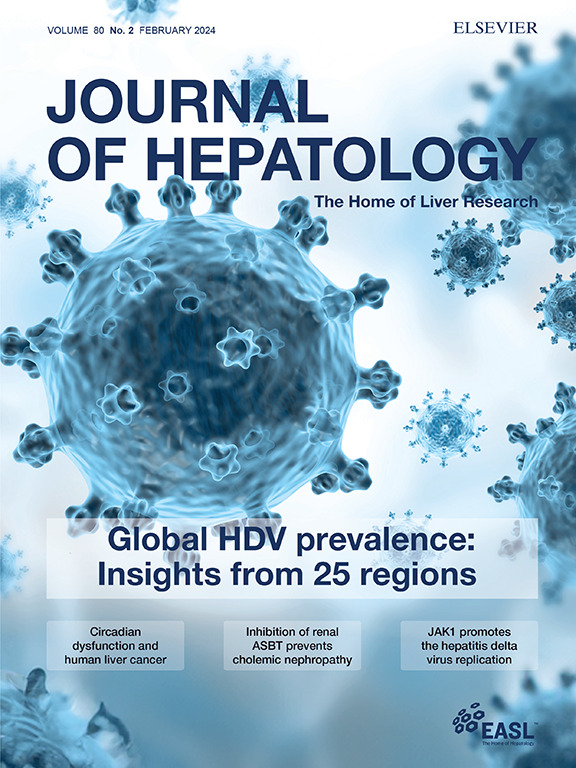重新思考肝性脑病:肠道微生物、神经毒素和治疗前景
IF 26.8
1区 医学
Q1 GASTROENTEROLOGY & HEPATOLOGY
引用次数: 0
摘要
背景和背景肝性脑病(HE)是肝脏疾病的严重并发症,表明失代偿性肝硬化和急性肝功能衰竭的进展,并与死亡风险增加相关。HE的发病机制主要由高氨血症驱动,高氨血症作为一种神经毒素,导致星形胶质细胞肿胀和脑水肿,从而促进疾病进展。此外,通常由肠道来源的内毒素引发的全身性炎症也起着重要的作用。目的、方法和发现为了探索肝脏疾病中脑功能障碍的机制,He X等人通过分析来自四个肝硬化患者队列的肠道宏基因组数据来研究肠脑轴。他们确定了与HE相关的肠-脑模块,单胺合成途径显示出最强的相关性。该途径主要存在于gnavus Ruminococcus (R. gnavus)中,由芳香l -氨基酸脱羧酶催化。进一步的分析揭示了新基因的发现意义she等人证明了肠道中的鼠可以产生PEA,这是一种神经活性分子,由于肝脏疾病中肝脏清除受损而在大脑中积累。然而,r.g gnavus在这一过程中的确切作用尚不清楚。目前尚不确定gnavus的参与是否是肝硬化相关生态失调的直接定量结果-其在肠道中的丰度增加-或者它是否是PDC表达的物种特异性改变作为对变化的反应。利益冲突详情请参阅随附的ICMJE披露表格。本文章由计算机程序翻译,如有差异,请以英文原文为准。
Rethinking hepatic encephalopathy: Gut microbes, neurotoxins and the therapeutic horizon
Section snippets
Background and context
Hepatic encephalopathy (HE) is a severe complication of liver disease, indicating progression in decompensated cirrhosis and acute liver failure, and is associated with an increased risk of mortality.[1], [2], [3] The pathogenesis of HE is primarily driven by hyperammonemia, which acts as a neurotoxin, leading to astrocyte swelling and cerebral edema, thus contributing to disease progression. Additionally, systemic inflammation, often triggered by gut-derived endotoxins, plays a significantObjectives, methods and findings
To explore the mechanisms of brain dysfunction in liver disease, He X et al. investigated the gut-brain axis by analyzing metagenomic data from the gut from four cohorts of patients with cirrhosis. They identified gut-brain modules associated with HE, with the monoamine synthesis pathway showing the strongest correlation. This pathway, catalyzed by aromatic L-amino acid decarboxylases was predominantly found in Ruminococcus gnavus (R. gnavus). Further analysis uncovered novel genes in theSignificance of findings
He et al. demonstrated that R. gnavus in the gut can produce PEA, a neuroactive molecule that accumulates in the brain due to impaired hepatic clearance in liver disease. However, the exact role of R. gnavus in this process remains unclear. It is uncertain whether the involvement of R. gnavus is a direct, quantitative result of cirrhosis-related dysbiosis – where its abundance increases in the gut – or if it is a species-specific alteration in PDC expression as a response to changingFinancial support
The author did not receive any financial support to produce this manuscript.Conflict of interest
Please refer to the accompanying ICMJE disclosure form for further details.求助全文
通过发布文献求助,成功后即可免费获取论文全文。
去求助
来源期刊

Journal of Hepatology
医学-胃肠肝病学
CiteScore
46.10
自引率
4.30%
发文量
2325
审稿时长
30 days
期刊介绍:
The Journal of Hepatology is the official publication of the European Association for the Study of the Liver (EASL). It is dedicated to presenting clinical and basic research in the field of hepatology through original papers, reviews, case reports, and letters to the Editor. The Journal is published in English and may consider supplements that pass an editorial review.
 求助内容:
求助内容: 应助结果提醒方式:
应助结果提醒方式:


